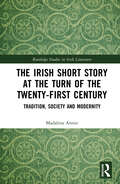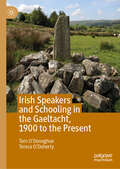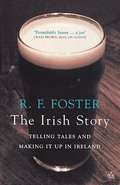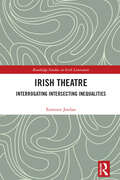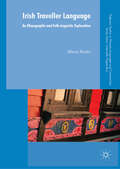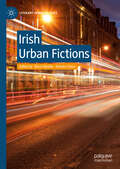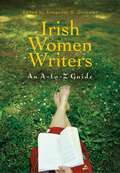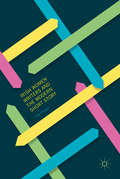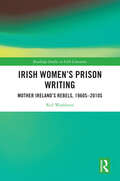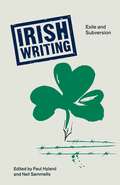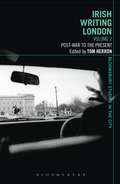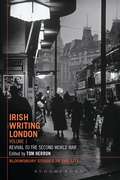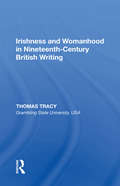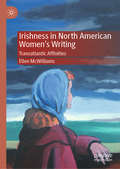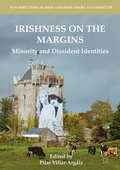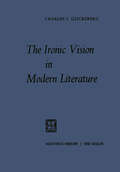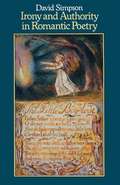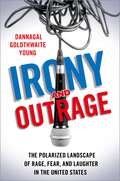- Table View
- List View
The Irish Short Story at the Turn of the Twenty-First Century: Tradition, Society and Modernity (Routledge Studies in Irish Literature)
by Madalina ArmieIn the mid-1990s, Ireland was experiencing the "best of times". The Celtic Tiger seemed to instil in the national consciousness that poverty was a problem of the past. The impressive economic performance ensured that the Republic occupied one of the top positions among the world’s economic powers. During the boom, dissident voices continuously criticised what they considered to be a mirage, identifying the precariousness of its structures and foretelling its eventual crash. The 2008 recession proved them right. Throughout this time, the Irish contemporary short story expressed distrust. Enabled by its capacity to reflect change with immediacy and dexterity, the short story saw through the smokescreen created by the Celtic Tiger discourse of well-being. It reinterpreted and captured the worst and the best of the country and became a bridge connecting tradition and modernity. The major objective of this book is to analyse the interactions between fiction and reality during this period in Ireland by studying the short stories written by old and emergent voices published between the birth of the Celtic Tiger in 1995 up to its immediate aftermath in 2013.
The Irish Short Story at the Turn of the Twenty-First Century: Tradition, Society and Modernity (Routledge Studies in Irish Literature)
by Madalina ArmieIn the mid-1990s, Ireland was experiencing the "best of times". The Celtic Tiger seemed to instil in the national consciousness that poverty was a problem of the past. The impressive economic performance ensured that the Republic occupied one of the top positions among the world’s economic powers. During the boom, dissident voices continuously criticised what they considered to be a mirage, identifying the precariousness of its structures and foretelling its eventual crash. The 2008 recession proved them right. Throughout this time, the Irish contemporary short story expressed distrust. Enabled by its capacity to reflect change with immediacy and dexterity, the short story saw through the smokescreen created by the Celtic Tiger discourse of well-being. It reinterpreted and captured the worst and the best of the country and became a bridge connecting tradition and modernity. The major objective of this book is to analyse the interactions between fiction and reality during this period in Ireland by studying the short stories written by old and emergent voices published between the birth of the Celtic Tiger in 1995 up to its immediate aftermath in 2013.
Irish Speakers and Schooling in the Gaeltacht, 1900 to the Present
by Tom O'Donoghue Teresa O'DohertyThis book offers the first full-length study of the education of children living within the Gaeltacht, the Irish-speaking communities in Ireland, from 1900 to the present day. While Irish was once the most common language spoken in Ireland, by 1900 the areas in which native speakers of Irish were located contracted to such an extent that they became clearly identifiable from the majority English-speaking parts. In the mid-1920s, the new Irish Free State outlined the broad parameters of the boundaries of these areas under the title of ‘the Gaeltacht’. This book is concerned with the schooling of children there. The Irish Free State, from its establishment in 1922, eulogized the people of the Gaeltacht, maintaining they were pious, heroic and holders of the characteristics of an invented ancient Irish race. Simultaneously, successive governments did very little to try to regenerate the Gaeltacht or to ensure Gaeltacht children would enjoy equality of education opportunity. Furthermore, children in the Gaeltacht had to follow the same primary school curriculum as was prescribed for the majority English speaking population. The central theme elaborated on throughout the book is that this schooling was one of a number of forces that served to maintain the people of the Gaeltacht in a marginalized position in Irish society.
The Irish Story: Telling Tales and Making it Up in Ireland
by R F FosterEach of Foster's books has generated vigorous discussion, but in THE IRISH STORY he breaks fresh ground even by his own standards. Driven by his sense of the seriousness of history and a fascination with those who distort it, THE IRISH STORY examines how key facets of Ireland's past have been tampered with to serve a multiplicity of purposes. THE IRISH STORY is endlessly varied, surprising and funny. It is also a rallying cry for those anxious that contemporary Ireland may be in danger ofturning itself into a meretricious historical theme-park.
Irish Theatre: Interrogating Intersecting Inequalities (Routledge Studies in Irish Literature)
by Eamonn JordanThis book on modern and contemporary Irish theatre traces how social, cultural and economic capital are circulated in order to demonstrate complex and often contradictory outlooks on equality/inequality. Individual chapters analyse property ownership and inheritance; wealth acquisition; employment conditions; educational access; intercultural encounters; sexual intimacy and violation; and acts of resistance, protest and solidarity. This book addresses complex intergenerational, intercultural, racial, sectarian, ethnic, gender and inter- and intraclass dynamics from the perspective of ranked, objectifying, exploitative and coercive relationships but also in terms of commonalities, complicities, reciprocations and retaliations. Notable are the significances of wealth precarity and shaming; the consequences of anti-materialistic dramaturgical leanings; the pathologising of success; the fraught nature of solidarity; and the problematics of merit, divisive partitioning and muddled mésalliances. Ultimately the book wonders about how Irish theatre distinguishes between tolerable and intolerable inequalities that are culturally and socially but principally economically derived.
Irish Theatre: Interrogating Intersecting Inequalities (Routledge Studies in Irish Literature)
by Eamonn JordanThis book on modern and contemporary Irish theatre traces how social, cultural and economic capital are circulated in order to demonstrate complex and often contradictory outlooks on equality/inequality. Individual chapters analyse property ownership and inheritance; wealth acquisition; employment conditions; educational access; intercultural encounters; sexual intimacy and violation; and acts of resistance, protest and solidarity. This book addresses complex intergenerational, intercultural, racial, sectarian, ethnic, gender and inter- and intraclass dynamics from the perspective of ranked, objectifying, exploitative and coercive relationships but also in terms of commonalities, complicities, reciprocations and retaliations. Notable are the significances of wealth precarity and shaming; the consequences of anti-materialistic dramaturgical leanings; the pathologising of success; the fraught nature of solidarity; and the problematics of merit, divisive partitioning and muddled mésalliances. Ultimately the book wonders about how Irish theatre distinguishes between tolerable and intolerable inequalities that are culturally and socially but principally economically derived.
Irish Traveller Language: An Ethnographic and Folk-Linguistic Exploration (Palgrave Studies in Minority Languages and Communities)
by Maria RiederThis book explores the Irish Traveller community through an ethnographic and folk linguistic lens. It sheds new light on Irish Traveller language, commonly referred to as Gammon or Cant, an integral part of the community’s cultural heritage that has long been viewed as a form of secret code. The author addresses Travellers’ metalinguistic and ideological reflections on their language use, providing deep insights into the culture and values of community members, and into their perceived social reality in wider society. In doing so, she demonstrates that its interrelationship with other cultural elements means that the language is in a constant flux, and by analysing speakers’ experiences of language in action, provides a dynamic view of language use. The book takes the reader on a journey through oral history, language naming practices, ideologies of languageness and structure, descriptions of language use and contexts, negotiations of the ‘authentic’ Cant, and Cant as ‘identity’. Based on a two-year ethnographic fieldwork project in a Traveller Training Centre in the West of Ireland, this book will appeal to students and scholars of sociolinguistics, language in society, language ideology, folk linguistics, minority communities and languages, and cultural and linguistic anthropology.
Irish Urban Fictions (Literary Urban Studies)
by Maria Beville Deirdre FlynnThis collection is the first to examine how the city is written in modern Irish fiction. Focusing on the multi-faceted, layered, and ever-changing topography of the city in Irish writing, it brings together studies of Irish and Northern Irish fictions which contribute to a more complete picture of modern Irish literature and Irish urban cultural identities. It offers a critical introduction to the Irish city as it represented in fiction as a plural space to mirror the plurality of contemporary Irish identities north and south of the border. The chapters combine to provide a platform for new research in the field of Irish urban literary studies, including analyses of the fiction of authors including James Joyce, Roddy Doyle, Kate O’Brien, Hugo Hamilton, Kevin Barry, and Rosemary Jenkinson. An exciting and diverse range of fictions is introduced and examined with the aim of generating a cohesive perspective on Irish urban fictions and to stimulate further discussion in this emerging area.
Irish Women Writers: An A-to-Z Guide (Non-ser.)
by Alexander G. GonzalezIrish women writers have a large following, and their works are attracting large amounts of scholarly and critical attention. Through roughly 75 alphabetically arranged entries written by more than 35 expert contributors, this reference overviews the lives and works of Irish women writers active in a range of genres and periods. Each entry includes a brief biography, a discussion of major works and themes, a survey of the writer's critical reception, and a list of works by and about the author. The volume closes with a selected, general bibliography.Ireland has an especially lively literary tradition, and works by Irish writers have long been recognized as interesting and influential. While male writers have received the bulk of the critical attention given to Irish literature, contemporary women writers are among the most widely read Irish authors. This reference overviews the lives and works of Irish women writers active in a range of periods and genres.Included are roughly 75 alphabetically arranged entries written by more than 35 expert contributors. Among the writers discussed are: ; Elizabeth Bowen ; Mary Dorcey ; Lady Isabella Augusta Gregory ; Anne Hartigan ; Norah Hoult ; Paula Meehan ; Iris Murdoch ; Edna O'Brien ; Katharine Tynan ; Sheila Wingfield ; And many more.Each entry includes a brief biography, a discussion of major works and themes, a review of the writer's critical reception, and a list of works by and about the writer. The volume closes with a selected, general bibliography.
Irish Women Writers and the Modern Short Story
by Elke D'hokerThis book traces the development of the modern short story in the hands of Irish women writers from the 1890s to the present. George Egerton, Somerville and Ross, Elizabeth Bowen, Mary Lavin, Edna O’Brien, Anne Enright and Claire Keegan are only some of the many Irish women writers who have made lasting contributions to the genre of the modern short story - yet their achievements have often been marginalized in literary histories, which typically define the Irish short story in terms of its oral heritage, nationalist concerns, rural realism and outsider-hero. Through a detailed investigation of the short fiction of fifteen prominent writers, this study aims to open up this critical conceptualization of the Irish short story to the formal properties and thematic concerns women writers bring to the genre. What stands out in thematic terms is an abiding interest in human relations, whether of love, the family or the larger community. In formal terms, this book traces the overall development of the Irish short story, highlighting both the lines of influence that connect these writers and the specific use each individual author makes of the short story form.
Irish Women's Prison Writing: Mother Ireland’s Rebels, 1960s–2010s (Routledge Studies in Irish Literature)
by Red WashburnThis book explores 50 years of Irish women’s prison writing, 1960s–2010s, connecting the work of women leaders and writers in Northern Ireland during the Troubles. This volume analyzes political communiqués, petitions, news coverage, prison files, personal letters, poetry and short prose, and memoirs, highlighting the personal correspondence, auto/biographical narratives, and poetry of the following key women: Bernadette McAliskey, Eileen Hickey, Mairéad Farrell, Síle Darragh, Ella O’Dwyer, Martina Anderson, Dolours Price, Marian McGlinchey (formerly Marian Price), Áine and Eibhlín Nic Giolla Easpaig (Ann and Eileen Gillespie), Roseleen Walsh, and Margaretta D’Arcy. This text builds on different fields and discourses to reimagine gender and genre as central to an interdisciplinary and intersectional prison archive. Centering Irish women’s prison writings, in order to challenge canonization in history and literature, this volume argues that women’s lives and words offer a different view of gender and nation as well as offer a fuller and more inclusive archive of Irish history and literature. Additionally, this book will point to the ways in which their politics of everyday life and their cultural work is a form of anti-colonial civil rights feminism, for it speaks truth to power in a world in which compliance and silence are valued. Overall, this text focuses on rethinking and recasting women’s voices and words in order to document and promote the ongoing Irish freedom struggle from an abolitionist feminist perspective.
Irish Women's Prison Writing: Mother Ireland’s Rebels, 1960s–2010s (Routledge Studies in Irish Literature)
by Red WashburnThis book explores 50 years of Irish women’s prison writing, 1960s–2010s, connecting the work of women leaders and writers in Northern Ireland during the Troubles. This volume analyzes political communiqués, petitions, news coverage, prison files, personal letters, poetry and short prose, and memoirs, highlighting the personal correspondence, auto/biographical narratives, and poetry of the following key women: Bernadette McAliskey, Eileen Hickey, Mairéad Farrell, Síle Darragh, Ella O’Dwyer, Martina Anderson, Dolours Price, Marian McGlinchey (formerly Marian Price), Áine and Eibhlín Nic Giolla Easpaig (Ann and Eileen Gillespie), Roseleen Walsh, and Margaretta D’Arcy. This text builds on different fields and discourses to reimagine gender and genre as central to an interdisciplinary and intersectional prison archive. Centering Irish women’s prison writings, in order to challenge canonization in history and literature, this volume argues that women’s lives and words offer a different view of gender and nation as well as offer a fuller and more inclusive archive of Irish history and literature. Additionally, this book will point to the ways in which their politics of everyday life and their cultural work is a form of anti-colonial civil rights feminism, for it speaks truth to power in a world in which compliance and silence are valued. Overall, this text focuses on rethinking and recasting women’s voices and words in order to document and promote the ongoing Irish freedom struggle from an abolitionist feminist perspective.
Irish Writing: Exile and Subversion (Insights)
by Paul HylandThis is a collection of original essays by international scholars which focuses on Irish writing in English from the eighteenth century to the present. The essays explore the recurrent motif of exile and the subversive potential of Irish writing in political, cultural and literary terms. Case-studies of major writers such as Swift, Joyce, and Heaney are set alongside discussions of relatively unexplored writing such as radical pamphleteering in the age of the French Revolution and the contribution of women writers to Nationalistic journalism.
Irish Writing London: Post-War to the Present (Bloomsbury Studies in the City)
by Tom HerronThe presence of Irish writers is almost invisible in literary studies of London. The Irish Writing London redresses the critical deficit. A range of experts on particular Irish writers reflect on the diverse experiences and impact this immigrant group has had on the city. Such sustained attention to a location and concern of Irish writing, long passed over, opens up new terrain to not only reveal but create a history of Irish-London writing. Alongside discussions of MacNeice, Boland and McGahern, the autobiography of Brendan Behan and identity of Irish-language writers in London is considered. Written by an internal array of scholars, these new essays on key figures challenge the deep-seated stereotype of what constitutes the proper domain of Irish writing, producing a study that is both culturally and critically alert and a dynamic contribution to literary criticism of the city.
Irish Writing London: Revival to the Second World War (Bloomsbury Studies in the City)
by Tom HerronThe presence of Irish writers is almost invisible in literary studies of London. The Irish Writing London redresses the critical deficit. A range of experts on particular Irish writers reflect on the diverse experiences and impact this immigrant group has had on the city. Such sustained attention to a location and concern of Irish writing, long passed over, opens up new terrain to not only reveal but create a history of Irish-London writing. Alongside discussions of Wilde, Shaw, Joyce and Yeats, the writing of the political nationalist Katharine Tynan and work of Irish-Language writer Ó Conaire is considered. Written by an international array of scholars, these new essays on key figures challenge the deep-seated stereotype of what constitutes the proper domain of Irish writing, producing a study that is both culturally and critically alert and a dynamic contribution to literary criticism of the city.
Irish Writing London: Post-War to the Present (Bloomsbury Studies in the City #Volume 2)
by Tom HerronThe presence of Irish writers is almost invisible in literary studies of London. The Irish Writing London redresses the critical deficit. A range of experts on particular Irish writers reflect on the diverse experiences and impact this immigrant group has had on the city. Such sustained attention to a location and concern of Irish writing, long passed over, opens up new terrain to not only reveal but create a history of Irish-London writing. Alongside discussions of MacNeice, Boland and McGahern, the autobiography of Brendan Behan and identity of Irish-language writers in London is considered. Written by an internal array of scholars, these new essays on key figures challenge the deep-seated stereotype of what constitutes the proper domain of Irish writing, producing a study that is both culturally and critically alert and a dynamic contribution to literary criticism of the city.
Irish Writing London: Revival to the Second World War (Bloomsbury Studies in the City #Volume 1)
by Tom HerronThe presence of Irish writers is almost invisible in literary studies of London. The Irish Writing London redresses the critical deficit. A range of experts on particular Irish writers reflect on the diverse experiences and impact this immigrant group has had on the city. Such sustained attention to a location and concern of Irish writing, long passed over, opens up new terrain to not only reveal but create a history of Irish-London writing. Alongside discussions of Wilde, Shaw, Joyce and Yeats, the writing of the political nationalist Katharine Tynan and work of Irish-Language writer Ó Conaire is considered. Written by an international array of scholars, these new essays on key figures challenge the deep-seated stereotype of what constitutes the proper domain of Irish writing, producing a study that is both culturally and critically alert and a dynamic contribution to literary criticism of the city.
Irishness and Womanhood in Nineteenth-Century British Writing
by Thomas TracyIn The Wild Irish Girl, the powerful Irish heroine's marriage to a heroic Englishman symbolizes the Anglo-Irish novelist Lady Morgan's re-imagining of the relationship between Ireland and Britain and between men and women. Using this most influential of pro-union novels as his point of departure, the author argues that nineteenth-century debates over what constitutes British national identity often revolved around representations of Irishness, especially Irish womanhood. He maps out the genealogy of this development, from Edgeworth's Castle Rackrent through Trollope's Irish novels, focusing on the pivotal period from 1806 through the 1870s. The author's model enables him to elaborate the ways in which gender ideals are specifically contested in fiction, the discourses of political debate and social reform, and the popular press, for the purpose of defining not only the place of the Irish in the union with Great Britain, but the nature of Britishness itself.
Irishness and Womanhood in Nineteenth-Century British Writing
by Thomas TracyIn The Wild Irish Girl, the powerful Irish heroine's marriage to a heroic Englishman symbolizes the Anglo-Irish novelist Lady Morgan's re-imagining of the relationship between Ireland and Britain and between men and women. Using this most influential of pro-union novels as his point of departure, the author argues that nineteenth-century debates over what constitutes British national identity often revolved around representations of Irishness, especially Irish womanhood. He maps out the genealogy of this development, from Edgeworth's Castle Rackrent through Trollope's Irish novels, focusing on the pivotal period from 1806 through the 1870s. The author's model enables him to elaborate the ways in which gender ideals are specifically contested in fiction, the discourses of political debate and social reform, and the popular press, for the purpose of defining not only the place of the Irish in the union with Great Britain, but the nature of Britishness itself.
Irishness in North American Women's Writing: Transatlantic Affinities
by Ellen McWilliamsThis book examines ideas of Irishness in the writing of Mary McCarthy, Maeve Brennan, Alice McDermott, Alice Munro, Jane Urquhart, and Emma Donoghue. Individual chapters engage in detail with questions central to the social or literary history of Irish women in North America and pay special attention to the following: discourses of Irish femininity in twentieth-century American and Canadian literature; mythologies of Irishness in an American and Canadian context; transatlantic literary exchanges and the influence of canonical Irish writers; and ideas of exile in the work of diasporic women writers.
Irishness on the Margins: Minority and Dissident Identities (New Directions in Irish and Irish American Literature)
by Pilar Villar-ArgáizThis collection examines the presence of minority communities and dissident voices in Ireland both historically and in a contemporary framework. Accordingly, the contributions explore different facets of what we term “Irish minority and dissident identities,” ranging from political agitators drowned out by mainstream narratives of nationhood, to identities differentiated from the majority in terms of ethnicity, religion, class and health; and sexual minorities that challenge heteronormative perspectives on marriage, contraception, abortion, and divorce. At a moment when transnational democracy and the rights of minorities seem to be at risk, a book of this nature seems more pressing than ever. In different ways, the essays gathered here remind us of the importance of ‘rethinking’ nationhood, by a process of denaturalisation of the supremacy of white heterosexual structures.
Irishness on the Margins: Minority and Dissident Identities (New Directions in Irish and Irish American Literature)
by Pilar Villar-ArgáizThis collection examines the presence of minority communities and dissident voices in Ireland both historically and in a contemporary framework. Accordingly, the contributions explore different facets of what we term “Irish minority and dissident identities,” ranging from political agitators drowned out by mainstream narratives of nationhood, to identities differentiated from the majority in terms of ethnicity, religion, class and health; and sexual minorities that challenge heteronormative perspectives on marriage, contraception, abortion, and divorce. At a moment when transnational democracy and the rights of minorities seem to be at risk, a book of this nature seems more pressing than ever. In different ways, the essays gathered here remind us of the importance of ‘rethinking’ nationhood, by a process of denaturalisation of the supremacy of white heterosexual structures.
Irony and Outrage: The Polarized Landscape of Rage, Fear, and Laughter in the United States
by Dannagal Goldthwaite YoungFor almost a decade, journalists and pundits have been asking why we don't see successful examples of political satire from conservatives or of opinion talk radio from liberals. This book turns that question on its head to argue that opinion talk is the political satire of the right and political satire is the opinion programming of the left. They look and feel like two different animals because their audiences are literally, two different animals. In Irony and Outrage, political and media psychologist Dannagal Goldthwaite Young explores the aesthetics, underlying logics, and histories of these two seemingly distinct genres, making the case that they should be thought of as the logical extensions of the psychology of the left and right, respectively. One genre is guided by ambiguity, play, deliberation, and openness, while the other is guided by certainty, vigilance, instinct, and boundaries. While the audiences for Sean Hannity and John Oliver come from opposing political ideologies, both are high in political interest, knowledge, and engagement, and both lack faith in many of our core democratic institutions. Young argues that the roles that these two genres play for their viewers are strikingly similar: galvanizing the opinion of the left or the right, mobilizing citizens around certain causes, and expressing a frustration with traditional news coverage while offering alternative sources of information and meaning. One key way in which they differ, however, concludes Young, is in their capacity to be exploited by special interests and political elites. Drawing on decades of research on political and media psychology and media effects, as well as historical accounts and interviews with comedians and comedy writers, Young unpacks satire's liberal "bias" and juxtaposes it with that of outrage's conservative "bias." She details how traits like tolerance for ambiguity and the motivation to engage with complex ideas shape our preferences for art, music, and literature; and how those same traits correlate with political ideology. In turn, she illustrates how these traits help explain why liberals and conservatives vary in the genres of political information they prefer to create and consume.
